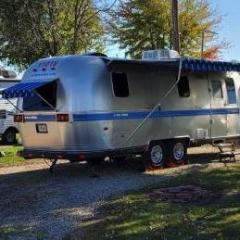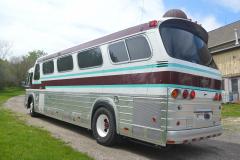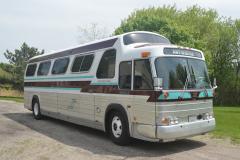-
Content Count
1997 -
Joined
-
Last visited
Content Type
Profiles
Forums
Blogs
Gallery
Everything posted by richard5933
-
My kitchen sink has periodic problem with the hot water having almost no water pressure. Ended up being a problem where the braided line connected to the brass fitting - the rubber was deformed when it was tightened down which flapped around in there. Annoying. Not saying that this is your problem, but please verify that the water flow to the toilet is consistent. If the water flow to the toilet is good and consistent, then that leaves the toilet valve. I did see quite a few people having trouble with the toilet valve on the 310. I guess you're lucky, since more people seem to have a problem with it not shutting off than with it having poor water flow.
-
Isn't a Coleman Mach an a/c unit? Looks like they can be installed with a heat pump feature. What year is your Tiffin? I was looking at the manual for the 2015 model, and it looks like they came with heat pumps in the a/c units and an Aqua Hot unit. Not sure exactly what you have, but if it's like the 2015 then the system automatically turns on the Aqua Hot when the temperature inside is such that the heat pump won't be able to handle it on its own. Hopefully someone with a Tiffin will join in and give you more specific info.
-
Have you confirmed that the water will continue to flow from the toilet supply line if the valve is open? Put the end in a bucket and open the water supply valve. Could be a blockage behind the supply valve and not in the toilet at all. If the supply is confirmed to be good, and you've confirmed that the toilet's valve works, then other than a few feet of plastic tubing and the vacuum breaker I don't see any parts which could be involved.
-
I think that there's also an LP version of the Aqua Hot system. http://www.aquahot.com/Products/RV/400P.aspx Please provide more information (coach make/model as well as the furnace make/model) and it will be easier to give you some help.
-
They also work on many MCI and Prevost buses, as well as a good number of motor homes. The only thing they won't do is factory warranty work, from what I understand. It does take a bit of sleuthing at first, but there are usually at least a couple of shops in any major city that will work on a bus. Just be sure to keep the snow off the solar panels. Sitting flat on a roof of a coach they won't shed the snow like they would on the roof of a house.
-
I'm wondering if this has something to do with the vacuum breaker? The water leaves the water valve and goes up to the vacuum breaker. If that thing gets stuck/clogs it seems that it will cut off the water to the toilet. That might explain why there is so much water in the valve when you change it. I can't find an exploded view of the vacuum breaker itself, so I don't know if there are any flappers or moving parts that could have gotten stuck. For a simple toilet, there are sure a lot of postings on various sites with problems though, so at least you're not alone.
-
Our bus has been winterized, just like any motor home would be. It spends the entire winter here in Wisconsin parked out behind the barn, snow covering the roof for much of the winter. I keep the bus plugged in, but that's only because I'm too lazy to bring all the batteries inside. If I did that, there is absolutely nothing on the bus that needs any attention, other than checking for mice and things once in a while. The only thing that you want to be certain of before parking a 20-year-old bus outside is that it does not have any leaks. Common leak points are around any roof openings and the windows. If you want to explore maintenance options beyond what the current owner uses, see if there is an MCI facility near you. Or, call a local charter company and see what facility they use. I take our bus to a shop in town that has contracts for a couple of smaller charter outfits, and they never hesitate to work on my 45-year-old bus.
-
Welcome! The manual for the toilet shows that there is a filter screen on the inlet to the water valve. When you pulled the valve did you notice the screen getting clogged? It doesn't take much debris to reduce water flow to nearly nothing, and if there are period of time with no water pressure behind the screen (like when you're between campgrounds) I could see how the debris could loosen up, only to re-clog the screen after a a few flushes.
-
Another thing to start looking at when you are browsing through all the sites looking at different makes/models is what you can't see. Is the construction of the motor home strong enough to withstand road travel over the long-run, and God forbid an accident. Some (older and newer) were built with sticks and staples, covered on the outside by a sheet of laminating material and on the inside by paper-thin wallboards. They are essentially boxes bolted (screwed) to the top of the chassis' platform. These may look good for a few years, but problems will develop. Not much left of them after an accident. Once you've spent time inside a quality coach, you will feel the difference as soon as you step inside one of these. The better coaches are built with a metal substructure, integrated wall panels, and much more structural integrity all around. A few of the higher-end coaches come pretty close to the construction of a bus and use a welded frame around the entire structure. Newell is probably the only motor home that builds essentially a bus chassis under their motorhomes, but others are getting close. Nearly all of the motor home companies allow you to download copies of their sales brochures going back many years. This is a great way to see what they were portraying as the selling points when the coach was new, and many will include cutaway views of things like the wall structure. If the chassis is one of the better ones, you'll see that touted as well. Never believe anything in an online ad for a used coach - go pull the brochure and confirm for yourself. I've seen listings with the wrong engines, transmissions, and capacities listed. Not everyone is trying to deceive, some just don't know what they are looking at when they open the engine bay, and some may just be errors. Either way, best to confirm for yourself. On the flip side, you've got to double check brochures sometimes - they were printed during pre-production, and at times changes are made once production begins due to design changes and parts availability, as well as custom orders. Tag axle is for weight. Once the coach gets above a certain GVWR six tires just isn't enough. Most coaches in the 35-foot range won't have them, and every coach at 42-45 feet will. There is some variance on what the cutoff is for adding them between brands and price points. Do you have an RV show near you? This is the time of year for them in many areas. Not that you're buying a new one, but RV shows are a great way to see the varieties of construction used and the different levels of build quality.
-
They are a big thing. Many of the founding members of FMCA owned bus conversions, and one of the first (maybe the first) commercial member was a co-founder of Custom Coach. Custom Coach was a trail blazer in the early years of the luxury motor home industry. You can read about the early days of Custom Coach here: https://www.farberspecialty.com/custom-luxury-vehicles/history You'd think so, but you can usually find well-kept 15-20 year old Prevost coaches at decent prices. A couple of really nice Prevost conversions from the 90s recently sold for $50 or less, and they had many useful years left. But you are correct - new these things cost high dollars. Our 1974 coach cost around $225K when it was built, the equivalent of nearly a million today. Obviously we paid less, MUCH less. You get what you pay for in motor homes. The higher-end (top tier) brands like Newmar, Tiffin, and many of the brands mentioned by the others above are built on heavy-duty chassis, often built by companies like Freightiner. They will handle well on the road and have good road manners. Then there are the less expensive models built on lighter-weight chassis, many of which are near or at their weight capacity when they leave the showroom. This is where the research comes in, so you can learn which brands and which models have the heavy-duty chassis and which don't. Our bus was converted in 1974 by Custom Coach on a brand-new chassis. Custom Coach was the premier conversion company in its day. This is our second bus conversion, and we bought it with only about 40K miles. We chose an older bus conversion for a few reasons... I like old vehicles and enjoy being able to work on them myself. I can't do as much on the bus as I did on the vintage cars that I've owned, I enjoy working on it. Everything on the bus side is purely mechanical, easy to understand, and doesn't require a computer lab. Then there's the styling and the retro look, which speaks for itself. And largely we chose a bus conversion because of the style of travel we do - we are on the road much more than we're parked in a campground, and we felt a bus chassis provided a high degree of road worthiness and safety. I can't speak for Kay's MCI, but we both have drive trains which have proven themselves for millions of miles of commercial service over decades. Both GM and MCI focused on building a bus which could be on the road day in and day out, so they over designed every system on these things. We have really stable platforms under our motor homes. All that said, bus conversions have their downsides too. They are not for everyone, and I've got nothing bad to say about the various options others have mentioned above.
-
From the album: 1974 GMC 4108
-
From the album: 1974 GMC 4108
-
From the album: 1974 GMC 4108
-
From the album: 1974 GMC 4108
-
From the album: 1974 GMC 4108
-
From the album: 1974 GMC 4108
-
From the album: 1974 GMC 4108
-
From the album: 1974 GMC 4108
-
From the album: 1974 GMC 4108
-
From the album: 1974 GMC 4108
-
From the album: 1974 GMC 4108
-
From the album: 1974 GMC 4108
-
I was thinking the same thing. There are some really nice professionally done bus conversions out there right now at great prices. If you want a 40-foot coach, there are both MCI and Prevost models out there. Same applies to these as any RV - get it inspected by someone knowledgeable so you know what you're buying. You might find a really nice coach for a price that still gives you enough left in your budget to do pretty extensive upgrades. The road-worthiness of a bus chassis is hard to beat in a motor home unless you buy a top-tier brand, and some of the conversions have interior finish quality as good as you'll find anywhere. You can find some conversions with slides, but if you don't need them you'll avoid lots of possible issues. This may not be for you, but it is certainly something to consider.
-
A big welcome from Wisconsin! Glad to have you join in.




